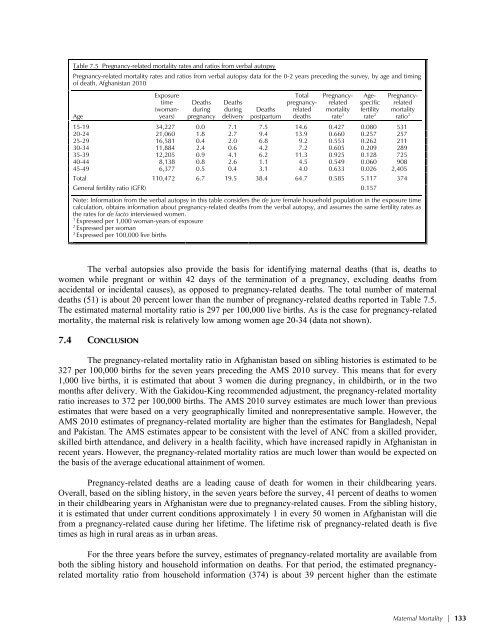Afghanistan Mortality Survey 2010 - Measure DHS
Afghanistan Mortality Survey 2010 - Measure DHS
Afghanistan Mortality Survey 2010 - Measure DHS
- No tags were found...
Create successful ePaper yourself
Turn your PDF publications into a flip-book with our unique Google optimized e-Paper software.
Table 7.5 Pregnancy-related mortality rates and ratios from verbal autopsyPregnancy-related mortality rates and ratios from verbal autopsy data for the 0-2 years preceding the survey, by age and timingof death, <strong>Afghanistan</strong> <strong>2010</strong>AgeExposuretime(womanyears)DeathsduringpregnancyDeathsduringdeliveryDeathspostpartumTotalpregnancyrelateddeathsPregnancyrelatedmortalityrate 1Agespecificfertilityrate 2Pregnancyrelatedmortalityratio 315-19 34,227 0.0 7.1 7.5 14.6 0.427 0.080 53120-24 21,060 1.8 2.7 9.4 13.9 0.660 0.257 25725-29 16,581 0.4 2.0 6.8 9.2 0.553 0.262 21130-34 11,884 2.4 0.6 4.2 7.2 0.605 0.209 28935-39 12,205 0.9 4.1 6.2 11.3 0.925 0.128 72540-44 8,138 0.8 2.6 1.1 4.5 0.549 0.060 90845-49 6,377 0.5 0.4 3.1 4.0 0.633 0.026 2,405Total 110,472 6.7 19.5 38.4 64.7 0.585 5.117 374General fertility ratio (GFR) 0.157Note: Information from the verbal autopsy in this table considers the de jure female household population in the exposure timecalculation, obtains information about pregnancy-related deaths from the verbal autopsy, and assumes the same fertility rates asthe rates for de facto interviewed women.1Expressed per 1,000 woman-years of exposure2Expressed per woman3Expressed per 100,000 live birthsThe verbal autopsies also provide the basis for identifying maternal deaths (that is, deaths towomen while pregnant or within 42 days of the termination of a pregnancy, excluding deaths fromaccidental or incidental causes), as opposed to pregnancy-related deaths. The total number of maternaldeaths (51) is about 20 percent lower than the number of pregnancy-related deaths reported in Table 7.5.The estimated maternal mortality ratio is 297 per 100,000 live births. As is the case for pregnancy-relatedmortality, the maternal risk is relatively low among women age 20-34 (data not shown).7.4 CONCLUSIONThe pregnancy-related mortality ratio in <strong>Afghanistan</strong> based on sibling histories is estimated to be327 per 100,000 births for the seven years preceding the AMS <strong>2010</strong> survey. This means that for every1,000 live births, it is estimated that about 3 women die during pregnancy, in childbirth, or in the twomonths after delivery. With the Gakidou-King recommended adjustment, the pregnancy-related mortalityratio increases to 372 per 100,000 births. The AMS <strong>2010</strong> survey estimates are much lower than previousestimates that were based on a very geographically limited and nonrepresentative sample. However, theAMS <strong>2010</strong> estimates of pregnancy-related mortality are higher than the estimates for Bangladesh, Nepaland Pakistan. The AMS estimates appear to be consistent with the level of ANC from a skilled provider,skilled birth attendance, and delivery in a health facility, which have increased rapidly in <strong>Afghanistan</strong> inrecent years. However, the pregnancy-related mortality ratios are much lower than would be expected onthe basis of the average educational attainment of women.Pregnancy-related deaths are a leading cause of death for women in their childbearing years.Overall, based on the sibling history, in the seven years before the survey, 41 percent of deaths to womenin their childbearing years in <strong>Afghanistan</strong> were due to pregnancy-related causes. From the sibling history,it is estimated that under current conditions approximately 1 in every 50 women in <strong>Afghanistan</strong> will diefrom a pregnancy-related cause during her lifetime. The lifetime risk of pregnancy-related death is fivetimes as high in rural areas as in urban areas.For the three years before the survey, estimates of pregnancy-related mortality are available fromboth the sibling history and household information on deaths. For that period, the estimated pregnancyrelatedmortality ratio from household information (374) is about 39 percent higher than the estimateMaternal <strong>Mortality</strong> | 133








![Obtaining Informed Consent for HIV Testing [QRS4] - Measure DHS](https://img.yumpu.com/49850117/1/190x245/obtaining-informed-consent-for-hiv-testing-qrs4-measure-dhs.jpg?quality=85)








